Originally published October 26, 2015 in Episode 27
I remember listening to ads about Ajinomoto growing up in Hà Nội. Ajinomoto is the first company that marketed the food flavor enhancer MSG, short for monosodium glutamate, for wide consumption. The Vietnamese call it "mì chính", or "bột ngọt".
In Hà Nội, if you are at a phở restaurant and ask for a broth sweetener, chances are you will be given MSG. At home, my mother puts it in almost every meal she cooks. She even adds it to dipping fish sauce to make it more flavorful.
So, what is MSG?
Ajinomoto-labeled bag of monosodium glutamate. (Photo: Dynomat. CC BY-SA 3.0)
MSG is a kind of concentrated salt. It contains glutamic acid, a building block of protein that is essential to the human body. It can be naturally found in common foods such as tomatoes, cheese, and soy sauce. Even human breast milk contains a significant amount of glutamic acid. Turns out, we are predisposed to like the taste of MSG since birth. When we eat MSG, glutamic acid is released to our brain. It triggers us into thinking the food is high in protein and thus, tasty.
In recent decades, there has been a pushback against MSG in the food industry.
“There is a mythology that has arisen about so-called Chinese Restaurant Syndrome that is attributed to monosodium glutamate, that it can cause people to have headaches, sweating and even seizures,” explains Dr. Joe Schwarcz, Director of McGill University’s Office for Science and Society, in a video posted on YouTube.
While Trace Dominguez from Discovery News recalls that MSG is often associated with Chinese restaurants, even though “[the restaurants themselves] usually say that they don’t use it.” Trace asks, “Why is MSG a dirty word in American cuisine but not in Asia?”
It all started in 1968 when Chinese American Dr. Robert Ho Man Kwok, wrote a letter to the New England Journal of Medicine and coined the term “Chinese Restaurant Syndrome” to describe his aches and pain after dining out. He theorized that MSG was the cause. Soon enough, there were many news reports saying that MSG was generally unhealthy. Even people who don’t know what MSG is or what it does think it’s bad.
In an MSG episode of the U.S. TV show Food Detectives, you can hear people complaining about symptoms such as sharp headaches or pulsating feelings under the eye.
Here’s the thing though: Science has not actually supported these claims. In fact, the Food and Drug Administration states, “The glutamate in MSG is chemically indistinguishable from glutamate present in food proteins. Our bodies ultimately metabolize both sources of glutamate in the same way.” In other words, MSG is safe to ingest in moderation as with any other food.
Now that we’ve settled the question about the safety of ingesting MSG, let’s talk about taste. Việt Nam's famous noodle soup, phở, is often flavored with MSG. The reason you feel so thirsty after having slurped a whole bowl of phở is due to the high content of sodium in the broth. MSG is nothing but a more delicious salt. So if you’re getting headaches or other symptoms after you eat any meal at a restaurant, it could just be the sodium content in general, not simply because of MSG.
But when it comes to phở, would the flavor be the same without MSG?
I ask my friend, Henry Trần, who loves phở so much he has to have it at least twice a week. To the question, “Do you think [phở] would taste the same without MSG?” Henry answered, “Probably not. But does it matter?”
Well, it is true that phở tastes great with or without MSG. But I hope I have busted some misconceptions about this often misunderstood flavor enhancer. So, next time you eat phở or any food item, go ahead and add MSG without fear of it getting in the way of a good meal.


